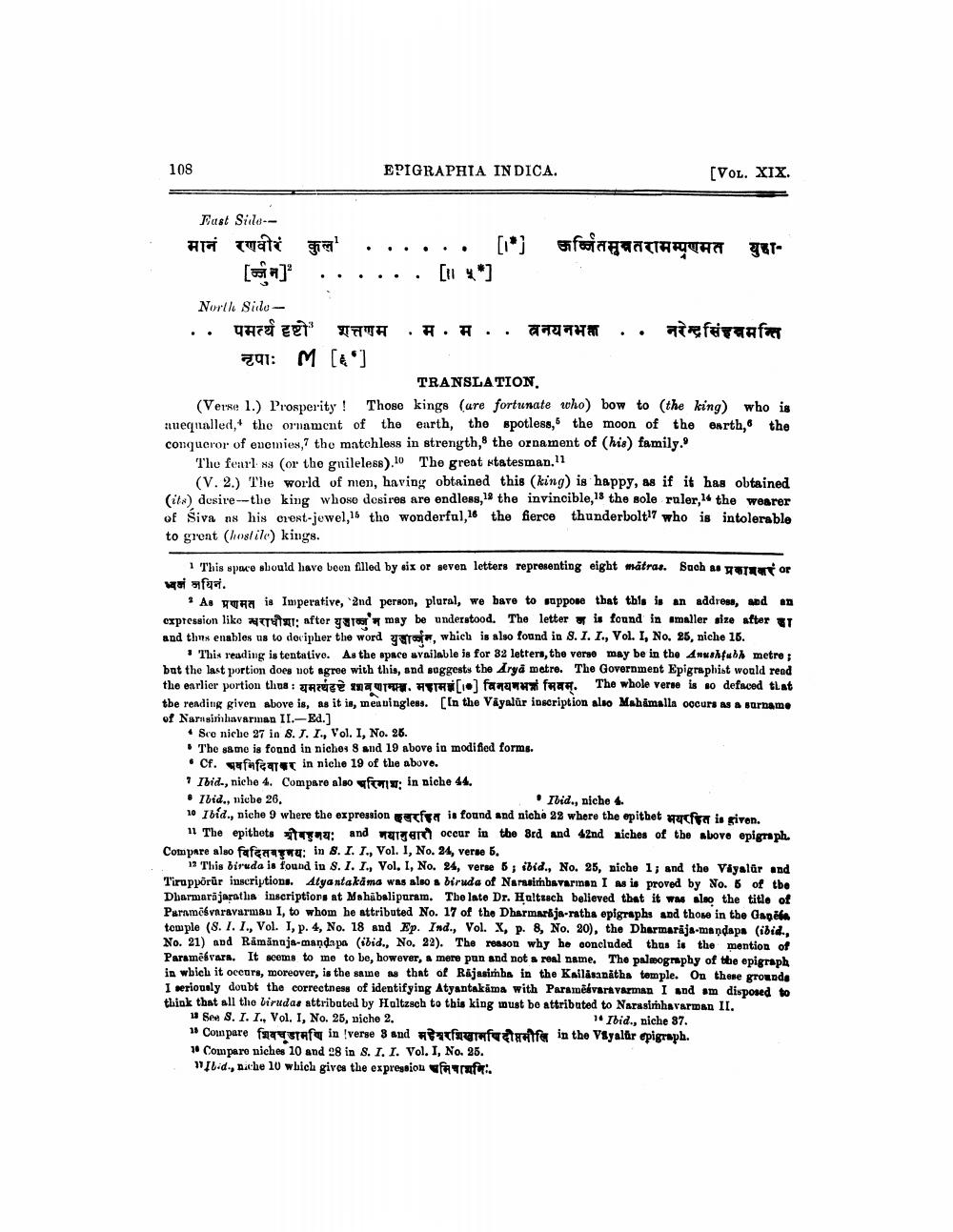________________
108
EPIGRAPHIA INDICA.
[VOL. XIX.
Fast Sido-- Ari mati gripit ...... [1"} ss for an ATTACHA gar
(Ha] ...... [114] North Side.. JAZZETTATA . #. #. . 7777*.. nefesaAfrT 791: M [4]
TRANSLATION (Verse 1.) Prosperity! Those kings are fortunate who) bow to the king) who is nuequalled,tho ornament of the earth, the spotless, the moon of the earth, the conqueror of enemies, the matchless in strength, the ornament of (his) family,
The fearls (or the gnilele68).10 The great statesman."
(V. 2.) The world of men, having obtained this (king) is happy, as if it has obtained (its) desire--the king whoso desires are endless, the invincible, the sole ruler, the wearer of Siva ns his crest-jewel,is the wonderful, 16 the fierce thunderbolt who is intolerable to gront (lostile) kings.
This space should have been filled by six or seven letters representing eight matras. Bach as URUYOR
. As wuha is Imperative, 2nd person, plural, we bare to rappone that this is an address, mod on expression liko H itat: after you may be understood. The letter is found in imaller size after I and that enables us to decipher the word guro, which is also found in 8. I. I., Vol. I, No. 25, niche 16.
This reading is tentative. As the space available is for 32 letters, the verso may be in the Anwolubb metre but the last portion does not agree with this, and suggests the Arya metre. The Government Epigraphist would read the enrlier portion thus : JARÚGÈ N . HETAN[IO] faqawwi fan. The whole verse is so defaced that the reading given above is, as it is, meaningless. [In the Vayalür inscription also Mahimalla occurs as a surname of Narasimhavarman II.-Ea.)
• Sre niche 27 in 8. J. I., Vol. I, No. 28. . The same is found in nichos 8 and 19 above in modified forms. • Cf. fafcater in nicle 19 of the above. * Ibid., niche 4. Compare also of : in niche 44. . Ibid., niebe 26.
Ibid., niche 4. 10 Ibíd., niche 9 where the expression surfear is found and niche 22 where the opithet weefs is given.
11 The epithets strua: and margard occur in the 3rd and 42nd niches of the above epigraph Compare also fafcawu: in 8. I. 1., Vol. 1, No. 24, verse 5.
12 This biruda is found in 8. 1. 1., Vol. I, No. 24, verse 5, ibid., No. 25, niche 1; and the Viyalar and Tirupporür inscriptions. Atyantakama was also a biruda of Narasimbavarman I as is proved by No. 6 of the Dharmarājaratha inscriptions at Mahabalipuram. The late Dr. Haltasch believed that it was also the title of Parnmösvaravarmau I, to whom he attributed No. 17 of the Dharmarija-ratha epigraphs and those in the Gapita temple (8. 1. I., Vol. 1, p. 4, No. 18 and Ep. Ind., Vol. X, p. 8, No. 20), the Dharmaraja-mandapa (ibid., No. 21) and Råmånajn-mandapa (ibid., No. 22). The reason why he concluded thus is the mention of Paramebrara. It seems to me to be, however, a mere pun and not a real name. The palmography of the epigraph in wbieh it occurs, moreover, is the same that of Rajasimbs in the Kailasanatha temple. On these ground, I seriously doubt the correctness of identifying Atyantakāma with Paramokvark varman I und um disposed to think that all the birudas attributed by Hultzsch to this king must be attributed to Narasimhavarman II. See 8. I. I.. Vol. I, No. 25, niche 2.
Ibid., niche 37. Compare fatturafa in verse 8 and natuurferatfe in the Vayalar epigraph.
Compare niches 10 and 28 in 8. 1. I. Vol. I, No. 25. 10.d., niche 10 which gives the expression fraft.




